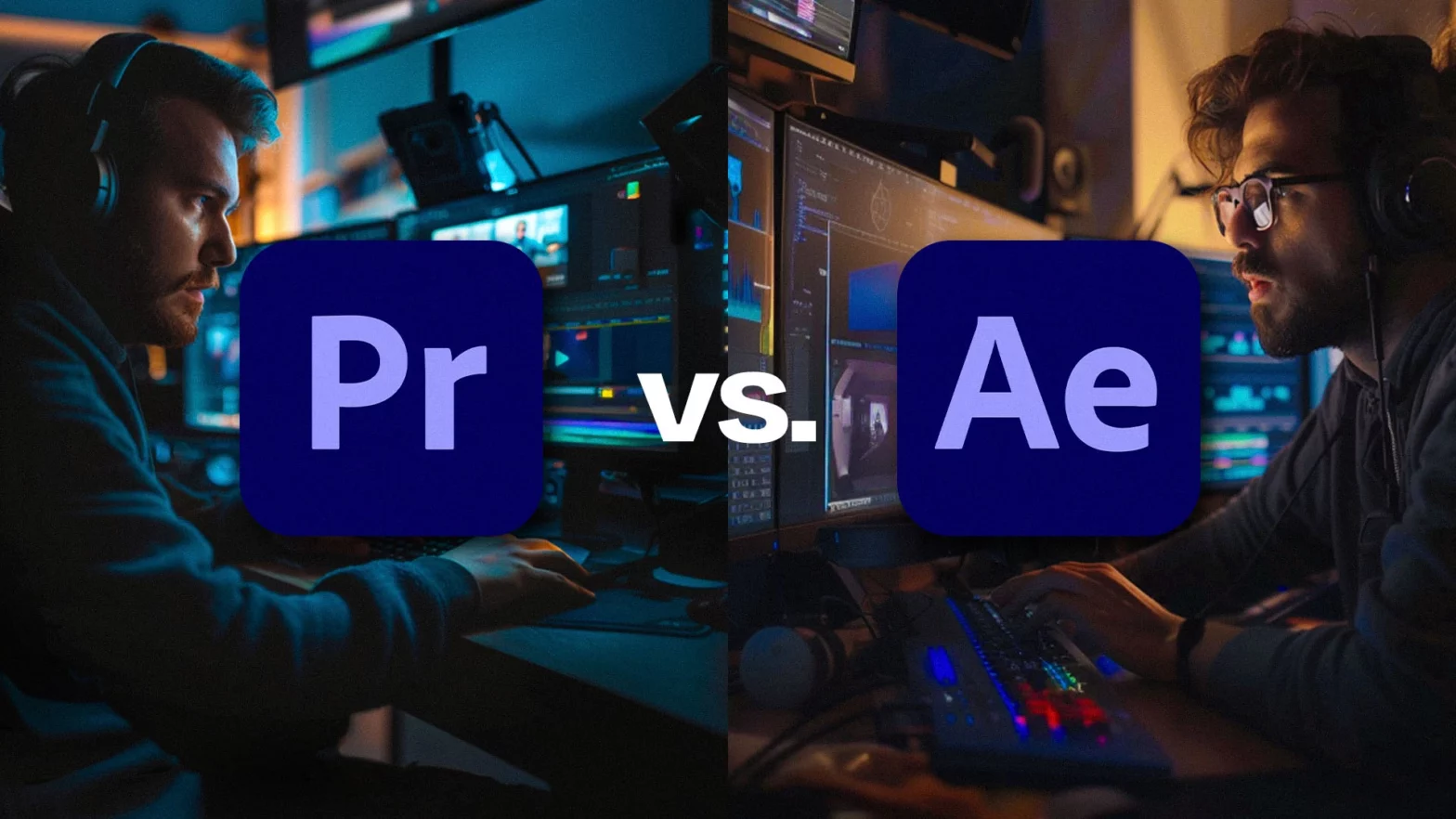Table of Contents
In the ever-evolving landscape of content creation, two powerhouse tools stand out: Adobe Premiere Pro and Adobe After Effects. These Adobe Creative Cloud stalwarts have become indispensable for filmmakers, video editors, animators, and content creators alike. But when it comes to deciding which tool to use for your project, the choice between Premiere Pro and After Effects can be daunting. Fear not! In this blog, we’ll explore After Effects vs. Premiere Pro and help you make an informed decision.
Premiere Pro: The Editing Maestro
Let’s kick things off with Adobe Premiere Pro, the go-to tool for video editing professionals. If your primary focus is on assembling footage, cutting sequences, and fine-tuning your masterpiece, Premiere Pro is your best friend. Here’s why:
- Timeline-Based Editing: Premiere Pro’s timeline interface is intuitive and familiar, making it easy to organise your clips, trim them, and arrange them into a cohesive narrative. Whether you’re editing a vlog, short film, or feature-length movie, the timeline is where the magic happens.
- Seamless Integration: As part of the Adobe Creative Cloud ecosystem, Premiere Pro seamlessly integrates with other Adobe applications like Photoshop and Audition. This integration streamlines your workflow, allowing you to edit graphics, apply audio enhancements, and more without leaving the Premiere Pro interface.
- Real-Time Collaboration: Collaboration is key in today’s fast-paced production environments. Premiere Pro offers robust collaboration features, enabling multiple editors to work on the same project simultaneously. Whether you’re working with a remote team or collaborating in-house, Premiere Pro keeps everyone on the same page.
- Efficient Rendering: Premiere Pro’s rendering engine is optimised for speed and efficiency, allowing you to preview your edits in real-time and export your final project with minimal delay. This is crucial for meeting tight deadlines and delivering high-quality content to your audience.
After Effects: The Visual Wizard
Now, let’s shift our focus to Adobe After Effects, the powerhouse of visual effects and motion graphics. While Premiere Pro excels at editing footage, After Effects takes your creativity to the next level with its array of visual effects and compositing tools. Here’s why you might choose After Effects:
- Motion Graphics Mastery: If you’re looking to add dynamic titles, animations, and visual effects to your videos, After Effects is the tool for the job. Its robust set of motion graphics tools allows you to create stunning visuals that captivate your audience and elevate your storytelling.
- Advanced Compositing: After Effects is renowned for its advanced compositing capabilities, allowing you to blend multiple layers of footage, graphics, and effects to create seamless visual compositions. Whether you’re creating green screen composites or complex VFX shots, After Effects gives you the tools you need to bring your imagination to life.
- Keyframe Animation: Keyframe animation is at the heart of After Effects, enabling you to create smooth, fluid animations with precise control over timing and motion. Whether you’re animating characters, objects, or text, After Effects empowers you to breathe life into your creations with ease.
- Dynamic Link with Premiere Pro: While After Effects shines in the realm of visual effects and motion graphics, it can also seamlessly integrate with Premiere Pro using Dynamic Link. This allows you to create dynamic compositions in After Effects and easily incorporate them into your Premiere Pro projects without the need for complicated workflows.
After Effects vs. Premiere Pro
So, which tool should you choose: Premiere Pro or After Effects? The answer ultimately depends on your specific needs and the nature of your project. Here are some key differences between after effects and premiere pro to help you make the right decision:
- Primary Focus: If your primary focus is on video editing and assembly, Premiere Pro is the way to go. Its timeline-based interface and editing-centric features make it ideal for projects that require seamless clip management and timeline manipulation.
- Visual Effects and Animation: If you’re looking to add dynamic visual effects, motion graphics, and animations to your videos, After Effects is your best bet. Its powerful compositing tools and keyframe animation capabilities open up a world of creative possibilities.
- Workflow Integration: Consider how your chosen tool integrates with your existing workflow and the other tools in your creative arsenal. If you’re already using other Adobe applications like Photoshop and Illustrator, the seamless integration between Premiere Pro and After Effects may sway your decision.
- Project Complexity: The complexity of your project is also a crucial factor to consider. For straightforward video edits, Premiere Pro may suffice. However, if your project requires advanced visual effects, compositing, and animation, After Effects is the way to go.
If you need more information on content creation, check out our blog on ‘How to Edit Your Vlogs‘ or ‘Common Editing Mistakes and How to Avoid Them‘.
In the battle of After Effects vs. Premiere Pro, there’s no clear winner—only the right tool for the job. Whether you’re a seasoned professional or a budding content creator, both Premiere Pro and After Effects offer unique strengths that can elevate your creative projects to new heights. By understanding the capabilities and differences of each tool, you can make an informed decision that empowers you to bring your creative vision to life. So, choose wisely, and let your imagination run wild!

